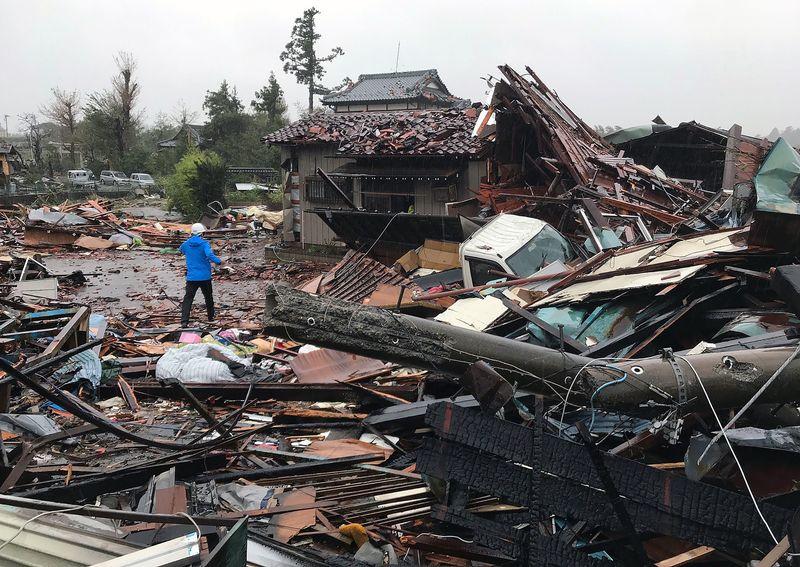The largest typhoon in recorded history of Japan's Shizuoka Prefecture caused widespread flooding, power outages and destruction on Saturday, as local authorities warned over 7 million people to evacuate, according to Bloomberg (with other sources quoting figures ranging from 1-4 million).

Typhoon Hagibis makes landfall on Japan's Izu Peninsula with heavy downpours and winds, leaving one person dead and 50 others injured https://t.co/yHxME8hMOP pic.twitter.com/lUb3l8IlkU— China Xinhua News (@XHNews) October 12, 2019
The sky turned brilliant purple right before Hagibis hit.
It might look lovely however this is a BIG calamity, Japan's skies turn profound shade of purple as Typhoon Hagibis is coming. #PRAYFORJAPAN pic.twitter.com/XxkgDOoF9B— binibini (@BinibiningAya_) October 12, 2019
According to the Japan Times, Typhoon Hagibis was downgraded to "strong" just prior to landfall, however "as of 8 p.m., it was still packing sustained winds of 144 kph and gusts of 198 kph. The storm is forecast to travel over Kanto region and then north into Tohoku region before moving into the Pacific."
"A typhoon of an unprecedented scale is about to hit Kanto. I’d like you to take actions to protect your own life," said Tokyo Gov. Kuriko Koike in an emergency news conference.
Dozens of rivers in the Tokyo region saw waters rise to dangerous levels on Saturday, while upstream dams are set to release water due to the heavy rains according to NHK. One of the largest rivers in the region, the Tama, has already begun to overflow into the residential district of Setagaya, per the land ministry.
"If we leave this situation unattended, the dam would collapse and more than 60 million tons of water would be unleashed at once," said Kanagawa Gov. Yuji Kuroiwa while announcing that the Shiroyama Dam in Sagamihara was scheduled to release water at 10 p.m.
More than 100 rivers were at risk of overflowing, including the Arakawa River in Tokyo’s Edogawa Ward, the Karasawa River in Saitama Prefecture and Koito River in Chiba Prefecture.The Tama River running between Tokyo and Kanagawa Prefecture began to overflow into the Tamagawa area of Tokyo’s Setagaya Ward at around 10:30 p.m. The area is better known as Futako-Tamagawa.The Chikuma River flooded in the city of Ueda and the city of Nagano, both in Nagano Prefecture, as did the Minami-Asakawa River in Hachioji and the Nariki River in Ome, both in Tokyo. -Japan Times
Flooding in the Tokyo suburb of Hachioji has overwhelmed the drainage system, causing it to gush out onto the street.#Hagibis #Typhoon— NHK WORLD News (@NHKWORLD_News) October 12, 2019
Click here for more updates:https://t.co/xZHPRNU5fb … pic.twitter.com/mHRtKg56TZ
Tokyo's Metropolitan government and Nagano Prefectural government have both asked Japan's Self-Defense Forces for assistance.
Hagibis is expected to bring violent winds to some areas. A maximum wind speed of 144 kilometers for the Kanto area, and 126 kilometers for the Tohoku region.#Hagibis #Typhoonhttps://t.co/bZpiKm8wINpic.twitter.com/4VEOzzA9a8— NHK WORLD News (@NHKWORLD_News) October 12, 2019
Local media reported earlier, citing Japanese meteorologists, that Super Typhoon Hagibis could become more destructive than the powerful 1958 Typhoon Ida that killed over 1,000.
The number of people, who died as a result of the Typhoon Hagibis in Japan, has increased to 14 while at least 16 more remain missing, the Kyodo news agency reported on Sunday.
The TBS broadcaster reported that the disaster had left about 150 people injured.
Earlier NHK said that at least 8 people were killed and more than 100 injured, adding that at least 16 people remain missing.
No comments:
Post a Comment